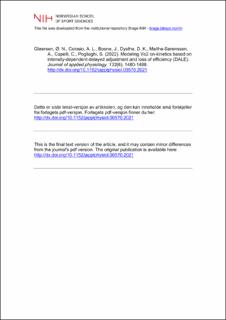| dc.contributor.author | Gløersen, Øyvind Nøstdahl | |
| dc.contributor.author | Colosio, Alessandro L. | |
| dc.contributor.author | Boone, Jan | |
| dc.contributor.author | Dysthe, Dag Kristian | |
| dc.contributor.author | Malthe-Sørenssen, Anders | |
| dc.contributor.author | Capelli, Carlo | |
| dc.contributor.author | Pogliaghi, Silvia | |
| dc.date.accessioned | 2023-06-23T11:57:07Z | |
| dc.date.available | 2023-06-23T11:57:07Z | |
| dc.date.created | 2022-09-13T19:38:34Z | |
| dc.date.issued | 2022 | |
| dc.identifier.citation | Journal of applied physiology. 2022, 132(6), 1480-1488. | en_US |
| dc.identifier.issn | 8750-7587 | |
| dc.identifier.uri | https://hdl.handle.net/11250/3072911 | |
| dc.description | I Brage finner du siste tekst-versjon av artikkelen, og den kan inneholde ubetydelige forskjeller fra forlagets pdf-versjon. Forlagets pdf-versjon finner du på journals.physiology.org / In Brage you'll find the final text version of the article, and it may contain insignificant differences from the journal's pdf version. The original publication is available at journals.physiology.org | en_US |
| dc.description.abstract | This study presents and evaluates a new mathematical model of V̇o2 on-kinetics, with the following properties: 1) a progressively slower primary phase following the size-principle of motor unit recruitment, explaining the delayed V̇o2 steady state seen in the heavy exercise intensity domain, and 2) a severe-domain slow component modeled as a time-dependent decrease in efficiency. Breath-by-breath V̇o2 measurements from eight subjects performing step cycling transitions, in the moderate, heavy, and severe exercise domains, were fitted to the conventional three-phase model and the new model. Model performance was evaluated with a residual analysis and by comparing Bayesian (BIC) and corrected Akaike (AICc) information criteria. The residual analysis showed no systematic deviations, except perhaps for the initial part of the primary phase. BIC favored the new model, being 9.3 (SD 7.1) lower than the conventional model whereas AICc was similar between models. Compared with the conventional three-phase model, the proposed model distinguishes between the kinetic adaptations in the heavy and severe domains by predicting a delayed steady-state V̇o2 in the heavy and no steady-state V̇o2 in the severe domain. This allows to determine when stable oxygen costs of exercise are attainable and it also represents a first step in defining time-dependent oxygen costs when stable energy conversion efficiency is not attainable. NEW & NOTEWORTHY: We propose and assess a new minimalistic integrated model for the V̇o2 on-kinetics, inspired by the currently available best evidence of the underlying mechanisms. We show that the model provides a similar fit as the conventionally used three-phase model, even though a stricter data fitting method is used for the proposed model. The proposed model clarifies misconceptions related to the V̇o2 slow component’s behavior, by clearly predicting that steady-state V̇o2 is attainable in the moderate and heavy exercise intensity domains. Furthermore, the model opens new possibilities for assessing oxygen cost during severe intensity exercise without the fallible assumption of time-constant energy-conversion efficiency. | en_US |
| dc.language.iso | eng | en_US |
| dc.subject | modeling | en_US |
| dc.subject | oxidative metabolism | en_US |
| dc.subject | primary component | en_US |
| dc.subject | vo2 kinetics | en_US |
| dc.title | Modeling V̇o2 on-kinetics based on intensity-dependent delayed adjustment and loss of efficiency (DALE) | en_US |
| dc.title.alternative | Modeling V̇o2 on-kinetics based on intensity-dependent delayed adjustment and loss of efficiency (DALE) | en_US |
| dc.type | Peer reviewed | en_US |
| dc.type | Journal article | en_US |
| dc.description.version | acceptedVersion | en_US |
| dc.source.pagenumber | 1480-1488 | en_US |
| dc.source.volume | 132 | en_US |
| dc.source.journal | Journal of applied physiology | en_US |
| dc.source.issue | 6 | en_US |
| dc.identifier.doi | 10.1152/japplphysiol.00570.2021 | |
| dc.identifier.cristin | 2051416 | |
| dc.description.localcode | Institutt for fysisk prestasjonsevne / Department of Physical Performance | en_US |
| cristin.ispublished | true | |
| cristin.fulltext | original | |
| cristin.fulltext | postprint | |
| cristin.fulltext | postprint | |
| cristin.qualitycode | 2 | |
